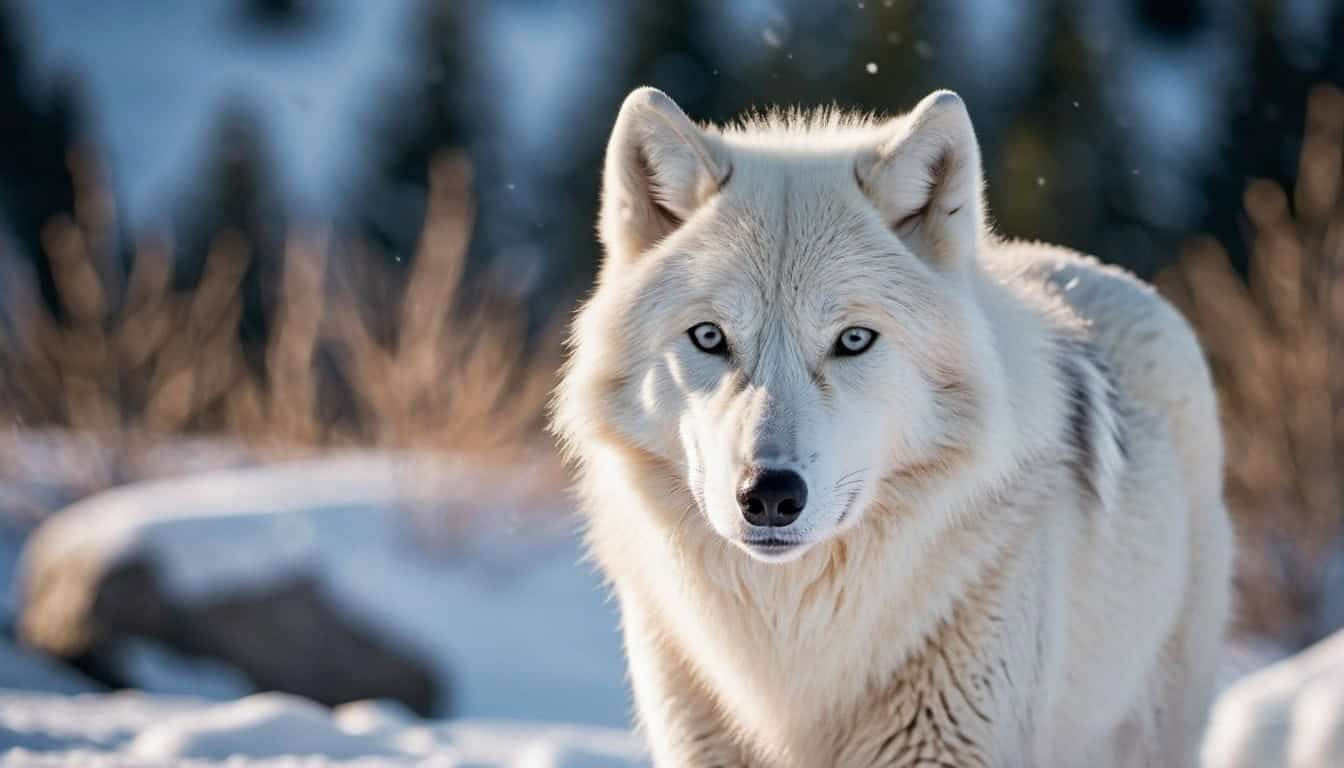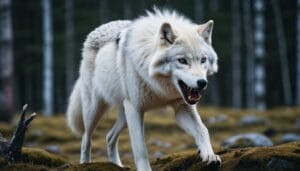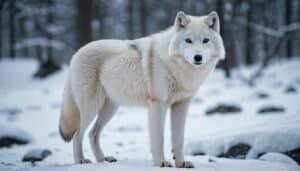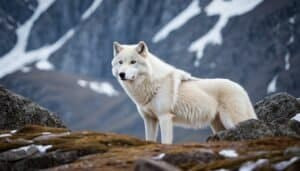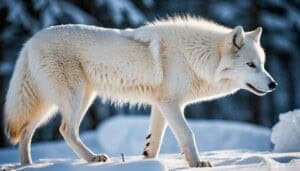Introduction
Arctic wolves, also known as white wolves, have adapted to survive in one of the harshest environments on Earth. Central to their survival is their ability to store fat efficiently
This article explores the mechanisms behind fat storage in Arctic wolves, including their unique metabolic processes and physiological adaptations
We will also delve into how diet, environmental factors, and genetics influence their ability to retain and utilize fat, ensuring they remain resilient during the frigid Arctic winters
Mechanisms and Metabolism of Fat Storage in Arctic Wolves
Arctic wolves have developed several intricate mechanisms to store fat, which is essential for their survival in extreme cold conditions. These mechanisms involve primary fat storage processes, seasonal changes affecting fat accumulation, and specific metabolic and physiological adaptations
Primary Fat Storage Mechanisms
The primary fat storage mechanisms in Arctic wolves revolve around their ability to deposit fat in various parts of their body, particularly around vital organs and beneath the skin. This subcutaneous fat layer acts as an insulating barrier, protecting them from the severe cold
Arctic wolves primarily store white adipose tissue, which is the body’s main form of fat storage. This fat is a significant energy reserve that can be mobilized when food is scarce
Arctic wolves consume large quantities of food when prey is abundant, leading to the accumulation of fat reserves
Their diet mainly consists of caribou, musk oxen, and Arctic hares, which are high in fats and proteins. During periods of food scarcity, particularly in winter, these fat reserves are metabolized to meet their energy needs
Seasonal Changes and Fat Storage
Seasonal changes play a crucial role in how Arctic wolves store and utilize fat
In the summer, when prey is more abundant, Arctic wolves increase their food intake to build up fat reserves. Studies have shown that Arctic wolves can gain significant weight during this period, storing fat that will be used in the leaner winter months (Mech, 1997)
As winter approaches and temperatures drop, the wolves’ metabolism adjusts to conserve energy and maximize the use of stored fat. This seasonal fat storage strategy is essential for maintaining their body temperature and ensuring they have enough energy to hunt and travel across their vast territories during the harsh winter months
Metabolic Processes Supporting Fat Storage
The metabolism of Arctic wolves is highly efficient at storing and utilizing fat. One of the key metabolic processes involved is lipogenesis, the process by which fatty acids are converted into fat for storage. This process is upregulated when food is plentiful, allowing the wolves to build up their fat reserves quickly
Conversely, during periods of food scarcity, lipolysis becomes the dominant process
Lipolysis involves the breakdown of stored fat into fatty acids and glycerol, which are then used as energy sources. This metabolic flexibility enables Arctic wolves to survive long periods without significant food intake, relying on their fat reserves to sustain them
Physiological Adaptations for Fat Storage
Arctic wolves possess several physiological adaptations that facilitate fat storage
Their thick fur not only provides insulation but also helps in retaining body heat, reducing the need for constant energy expenditure to stay warm. This means that more of the energy they consume can be directed towards fat storage rather than immediate metabolic needs
Additionally, Arctic wolves have a lower basal metabolic rate (BMR) during the winter. A lower BMR means they require less energy to maintain basic bodily functions, allowing them to conserve their fat reserves for longer periods. This adaptation is crucial for their survival during the long, harsh Arctic winters when hunting opportunities are limited
Role of Brown Fat in Arctic Wolves
While white fat is the primary storage form, brown fat also plays a vital role in Arctic wolves. Brown fat, or brown adipose tissue (BAT), is specialized for heat production. It contains a high number of mitochondria, which are responsible for burning fat to produce heat, a process known as thermogenesis
In Arctic wolves, brown fat is primarily located around the neck and shoulder regions
This brown fat is crucial for maintaining body temperature in extreme cold, especially for pups and younger wolves, who are more vulnerable to hypothermia. The presence of brown fat ensures that Arctic wolves can generate heat rapidly, aiding their survival in subzero temperatures
Energy Needs and Fat Balance
Balancing energy needs with fat storage is a constant challenge for Arctic wolves
They must consume enough food to sustain their immediate energy requirements while also storing sufficient fat for future use. This balance is influenced by various factors, including prey availability, environmental conditions, and the wolves’ physiological state
Research indicates that Arctic wolves can adjust their hunting strategies and foraging behaviors based on the availability of prey and their current fat reserves (Walton et al., 2018). For example, during times of scarcity, they may travel greater distances or target smaller, less energy-dense prey to conserve their fat stores
Diet and Environmental Factors in Fat Storage
Arctic wolves’ ability to store fat is heavily influenced by their diet and the environmental conditions they live in. Understanding these influences provides a comprehensive picture of how these animals prepare for and survive the harsh Arctic winters
Dietary Sources of Fat
The diet of Arctic wolves is rich in fat and protein, essential for building up the necessary reserves to survive in their extreme environment
Their primary prey includes large mammals such as caribou and musk oxen, as well as smaller animals like Arctic hares and birds. These prey animals provide the necessary nutrients, particularly fats, that the wolves need to store energy
Caribou and musk oxen are especially important during the summer months when these animals are more accessible. They have high-fat content, particularly in their organs and subcutaneous tissues. Consuming these parts allows Arctic wolves to quickly accumulate fat reserves
According to a study by Mech (1997), wolves in the Arctic can consume up to 20% of their body weight in a single meal, maximizing their fat intake when food is plentiful
Hunting Behavior and Fat Storage
The hunting behavior of Arctic wolves is closely linked to their fat storage needs. During the summer and early autumn, when prey is more abundant, Arctic wolves engage in more frequent and intensive hunting. This period is crucial for building up fat reserves that will sustain them through the winter
Arctic wolves often hunt in packs, which increases their efficiency in taking down large prey like caribou
This cooperative hunting behavior ensures that they can secure enough food to build significant fat reserves. When prey is less abundant, typically during winter, wolves may hunt smaller animals or scavenge on carrion, utilizing their stored fat to meet energy demands
Impact of Seasonal Diet Changes
Seasonal changes in diet significantly impact fat storage in Arctic wolves. During the summer months, the abundance of prey allows them to consume more fat and protein, leading to increased fat storage. In contrast, during the winter, when prey is scarce, they rely more heavily on their fat reserves to survive
The variation in prey availability and diet composition means that Arctic wolves must be highly adaptable
Their ability to switch between periods of feasting and fasting is a testament to their evolutionary adaptations. This cyclical pattern of food consumption and fat storage is vital for their survival in an environment where food availability is unpredictable
Environmental Factors Affecting Fat Storage
Environmental factors play a critical role in fat storage for Arctic wolves. The extreme cold and varying prey availability throughout the year dictate their energy needs and fat storage strategies. The harsh Arctic climate means that maintaining body heat is a constant challenge, and stored fat is essential for insulation and energy
The presence of snow and ice affects the hunting efficiency of Arctic wolves
Deep snow can hinder their ability to chase down prey, making fat reserves even more crucial during these times. Additionally, long periods of darkness during the Arctic winter limit their hunting opportunities, further emphasizing the importance of fat storage
Adaptations to Seasonal Scarcity
Arctic wolves have developed several adaptations to cope with seasonal food scarcity. One key adaptation is their ability to enter a state of reduced metabolic rate during the winter months
This state allows them to conserve energy and extend the use of their fat reserves. According to a study by Walton et al. (2018), Arctic wolves exhibit a significant decrease in activity levels and metabolic rate during winter, helping them to survive on their stored fat
Balancing Fat Storage and Energy Needs
Balancing fat storage with immediate energy needs is a constant challenge for Arctic wolves. They must consume enough food to sustain their current activities while also storing sufficient fat for the future. This balance is influenced by prey availability, environmental conditions, and the wolves’ physiological state
Arctic wolves are highly strategic in their feeding behavior. During times of abundance, they prioritize consuming high-fat content parts of their prey. This behavior ensures that they maximize their fat intake when food is available, allowing them to build substantial reserves for leaner times
Genetic Influences and Comparisons
Arctic wolves’ ability to store fat is not only influenced by their diet and environment but also by genetic factors that determine their physiological and metabolic responses to the extreme Arctic conditions. Understanding these genetic influences helps explain the remarkable adaptations of Arctic wolves and provides a comparative analysis with other canines
Genetic Factors Influencing Fat Storage
Genetic factors play a significant role in the fat storage capabilities of Arctic wolves
Specific genes regulate metabolism, fat storage, and energy utilization, enabling these wolves to survive in their harsh environment. Research into the genetic makeup of Arctic wolves has revealed several key genes that are involved in these processes
One of the crucial genetic factors is the regulation of lipogenesis and lipolysis. Genes that control these metabolic pathways are upregulated or downregulated depending on the season and availability of food. This genetic regulation ensures that Arctic wolves can efficiently store fat during periods of abundance and mobilize these fat reserves when needed
Additionally, the presence of certain alleles associated with efficient energy metabolism and fat storage has been identified in Arctic wolves. These genetic traits are likely a result of natural selection, favoring individuals who can better withstand the extreme cold and scarcity of food
A study by Carmichael et al. (2007) found that Arctic wolves possess unique genetic markers that differentiate them from other wolf populations, highlighting their specialized adaptations
Comparison with Other Canines
When comparing Arctic wolves to other canines, several differences in fat storage mechanisms and adaptations become apparent. While all canines have the ability to store fat, the extent and efficiency of this storage vary significantly
For example, gray wolves (Canis lupus) in temperate regions also store fat but not to the same extent as Arctic wolves. The milder climate and more consistent prey availability mean that gray wolves do not need to build up as extensive fat reserves. Their genetic adaptations are geared more towards endurance and hunting efficiency rather than extreme fat storage
Similarly, domestic dogs (Canis lupus familiaris) exhibit a wide range of fat storage capabilities depending on their breed and environment
Breeds that originated in colder climates, such as Alaskan Malamutes and Siberian Huskies, tend to have better fat storage mechanisms compared to those from warmer regions. However, the controlled environment and regular feeding patterns of domestic dogs mean they rely less on these adaptations
Arctic foxes (Vulpes lagopus), another species living in the Arctic, also show similar adaptations to fat storage as Arctic wolves. Both species have evolved to maximize fat storage during the short summer months and utilize these reserves during the long, harsh winters
However, the smaller size of Arctic foxes means they have different metabolic rates and fat storage capacities compared to Arctic wolves
Genetic Variability and Adaptation
The genetic variability within Arctic wolf populations also contributes to their ability to adapt to changing environmental conditions
Genetic diversity allows for a range of physiological responses to food scarcity and extreme cold. This diversity is crucial for the long-term survival of the species, enabling them to cope with various challenges posed by their environment
Studies have shown that populations of Arctic wolves in different regions exhibit slight genetic differences, likely due to local adaptations. For instance, wolves in areas with harsher winters and less prey availability may have evolved more efficient fat storage mechanisms compared to those in slightly milder regions
Ongoing Genetic Research
Ongoing genetic research continues to uncover new insights into the adaptations of Arctic wolves. Advances in genomic technologies allow scientists to study the entire genome of these animals, identifying specific genes and genetic markers associated with fat storage and metabolism
For example, recent studies have used whole-genome sequencing to compare the genetic makeup of Arctic wolves with other wolf populations and related species. These studies aim to pinpoint the exact genetic variations that contribute to their unique adaptations, providing a deeper understanding of the evolutionary processes at play
Conclusion
Arctic wolves have developed a range of specialized adaptations to survive in one of the harshest environments on Earth. Central to their survival strategy is their ability to store fat efficiently, which provides them with the necessary energy and insulation during the long, frigid Arctic winters
This article has explored the intricate mechanisms of fat storage in Arctic wolves, including their primary fat storage processes, metabolic adaptations, and the influence of diet and environmental factors
We’ve delved into the primary fat storage mechanisms, highlighting how Arctic wolves accumulate fat in various parts of their bodies, particularly during the summer when prey is abundant
Their metabolism supports this fat storage through processes like lipogenesis and lipolysis, which are regulated seasonally to maximize energy efficiency. Physiological adaptations, such as thick fur and a lower basal metabolic rate, further enhance their ability to conserve energy and survive the extreme cold
The diet of Arctic wolves, rich in fats and proteins from prey like caribou and musk oxen, plays a crucial role in their fat storage capabilities. Seasonal variations in prey availability lead to changes in their feeding behavior, emphasizing the importance of building fat reserves during times of abundance
Environmental factors, including harsh weather conditions and limited hunting opportunities in winter, underscore the necessity of these fat stores
Genetic factors also significantly influence the fat storage mechanisms of Arctic wolves. Specific genes regulate their metabolism and energy utilization, enabling them to efficiently store and mobilize fat
Comparisons with other canines, such as gray wolves and domestic dogs, reveal the unique adaptations of Arctic wolves to their extreme environment. Genetic variability within Arctic wolf populations further contributes to their adaptability and resilience
In conclusion, the ability of Arctic wolves to store fat is a multifaceted adaptation that involves complex physiological, metabolic, and genetic mechanisms. These adaptations ensure their survival in the harsh Arctic climate, allowing them to endure long periods of food scarcity and extreme cold
Ongoing research continues to shed light on the genetic underpinnings of these adaptations, enhancing our understanding of the remarkable resilience of Arctic wolves
